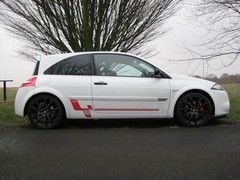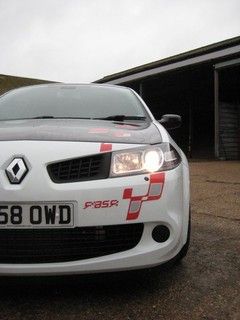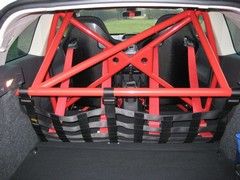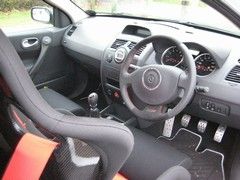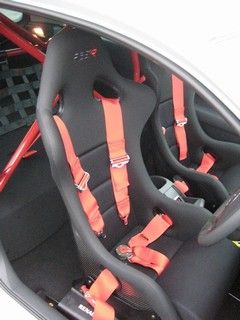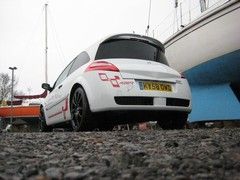Renaultsport Mégane R26.R
The most extreme hatch ever from a volume manufacturer? PH reader David Jones reports
With the all-new Mégane 3 appearing on the road in increasing numbers, the R26.R is Renaultsport’s snarling, stripped-out send-off to its predecessor, writes owner and Pistonheads reader David Jones:
Two seats, a rollcage, six-point harnesses and Perspex rear windows don’t sound like typical hot hatch ingredients, but the Renault Mégane Renaultsport R26.R, to give it its full name, is no ordinary hot hatch.
The Renaultsport Mégane 225 made a quietly reserved arrival in 2004 and, following a lukewarm press reception, the team at Dieppe continually looked at ways of improving on it. This started with the limited-run Trophy that introduced the Cup chassis in 2005, but it was just over a year later when the LSD-equipped R26 arrived that the hatch with the big behind really began to make waves amongst its rivals.
That takes us to the R26.R, launched at the British International Motor Show last year and based upon the R26. It is, according to Renault, ‘probably the most extreme car ever produced by a volume manufacturer’ and currently lays claim to the front-wheel drive production car lap record of the Nürburgring Nordschleife - for the time being.
In the quest to shed as much weight as possible, the whole rear seat assembly has been left in France, along with the entire audio system, front fog lamps, rear washer/wipers, every airbag bar the driver’s and the majority of the soundproofing. There’s not even a Mégane badge on the bootlid. Some of the heavy bits that couldn’t simply be tossed away have also come under Renaultsport’s scrutiny; carbon fibre-shelled Sabelt race seats have been fitted in place of the usual Recaros, while the windows aft of the doors are now made from extremely flimsy polycarbonate (you just have to poke them), the bonnet has been fashioned out of chav-spec bare carbon fibre, and any nice silver-coloured trim from the interior of a regular R26 has vanished. All of this effort adds up to a total – and not insignificant – weight saving of 123kgs over the R26, from which a further 9kgs can be deducted if you opt for the £2200 Titanium exhaust system. However you do have to factor in an additional 14kgs if you would like your ballistic hatch to contain a half roll cage, complete with track day-orientated Toyo Proxes R888 tyres.
Cosmetic changes amount to a subtle new rear spoiler, a new (but no lighter) wheel design and ever more garish decals, as well as a choice of three colours new to the Mégane, including the love-it-or-hate-it £1200 primer, sorry, Lunar Grey.
The weight saving alone lops half a second from the R26’s 6.5 second 0-62mph dash because, curiously, and perhaps a sign of the times in which we live, the R26.R has not one extra horsepower over the 227bhp of the R26. Top speed thus remains unchanged at 147mph. So how does all this weight-saving manifest itself behind the wheel?
Until you get the hang of it at least, you flop rather ungraciously into the deeply sculpted Sabelt seat, only then realizing you’ve forgotten to neatly arrange the six-point harnesses before entry. Once they’ve been dug out from underneath you and (very) securely fastened, you’re finally ready to thumb the starter button and, oh… even with the Titanium exhaust, it sounds just like any other Renaultsport Mégane.
Trundling through city traffic, the first thing that strikes you is how refined the car is. Considering the fairly obvious lack of normal hot hatch ingredients, you expect it to be overtly loud in the cabin and uncomfortably unforgiving over the road’s imperfections, but it just isn’t. It’s only when the sticky Toyos flick stones up onto the underside of the car that you begin to notice the places from which the soundproofing is absent. The springs and dampers are actually softer than those found on the R26, leading to a ride that’s certainly firm, but never outrageously so. Another thing you notice driving through town is how many admiring glances the car attracts – no doubt this is aided by this particular car’s less than subtle colour scheme, but rarely has a Renault earned quite so much attention, Clio V6 not withstanding, of course.
It’s only when the roads become twistier that the R26.R really comes into its own. Suddenly it all makes sense. To most people, the concept of a hot hatch with only two seats is a thoroughly silly one, but through a particularly sweet sequence of B-road sweepers, this car makes you wonder why all hot hatches aren’t like this.
The lack of weight makes itself apparent in almost everything the car does – it turns in more keenly than before, stops with less drama, accelerates harder and, most obviously, is willing to change direction like hot hatches haven’t done for a long while. When you’ve got the throttle nailed, for those few moments, it seems like the best idea in the world to throw out the rear seats and fit a two thousand pound exhaust system. All the rear bench would do is get in the way of the manic noise that erupts from what sounds like somewhere between you and the rear wheels. To give an accurate idea of the shriek from the Ti exhaust isn’t something that can be done without a microphone and a set of large speakers, but imagine Darth Vader with a turbocharger attached and you’d be on the right lines.
The first time you tap into the power of the Brembo four-pot brakes, complete with all-new, more fade-resistant grooved discs, the six-point harnesses that quickly became irksome in town driving soon show their worth. To say they inspire more confidence would be wrong, but they certainly bring about an air of being more at one with the car when pressing on, both when braking and during hard cornering.
On a dry surface, the mechanical grip generated by the pairing of track-biased tyres and the R26’s LSD is nothing short of sensational; the subtle influence of the diff allowing you to get on the power earlier than you ever would have thought possible. It really is one of those cars in which you can dissect a road, turn right around at the end and do it all again in the other direction. It’s there with you every step of the way, goading you to brake that little bit later and squeeze the throttle a little harder.
You’re instantly struck by the feeling that a lot of development work has gone into getting the suspension setup just right, and you quickly begin attacking corners with more and more confidence, comfortable in the knowledge that the car will be able to soak up any unfortunate mid-corner bumps should they appear. This high-speed compliance comes as something of a surprise considering the track car credentials, and it turns out the R26.R hasn’t just been built for track days after all.
The signals the driver receives through the part-suede steering wheel aren’t particularly enlightening as to what is happening down at road level, but you do get a decent enough relay of information through the chassis itself. It’s always apparent that all four wheels are working together beneath you, but losing pounds over the rear axle has really liberated the rear tyres in particular, endowing the car with a scalpel-sharp turn-in and providing the driver with any number of options mid-corner.
It’s not all plain sailing, though. Perhaps as a result of the optional tyres fitted to this car, breakaway from traction is slightly more abrupt than you might expect, especially when even a small lift of the throttle is enough to snap the car sideways into lift-off oversteer. The quick and nicely-weighted steering makes it easy enough to correct, but it could catch out the unwary, especially on the cold and damp tarmac at this time of year.
Despite Renault opting not to turn up the boost, the chassis does feel as if it could cope with a little more power, such is its ability. It’s not that the 2.0-litre unit isn’t capable, but it is certainly now the weakest part of the package with the rest of the car being so good. Another engine bugbear is that whilst throttle response is very impressive for a turbocharged car, it does seem somewhat reluctant to give its full effect higher up the rev-range, really losing its hunger for the redline over the last few hundred RPM. It could be down to the relatively few miles this engine has covered, but it is certainly in stark contrast to the rev-fest that is the Renaultsport Clio 197. You might also want to carefully consider your passenger choices; the g-forces this car can muster would be enough to turn some tummies green and the harnesses don’t make for a particularly quick exit!
What we have here, then, is an ordinary family hatch that has been morphed into something so vastly different from its original concept that it’s actually become not only point-to-point faster, but also more accomplished as a sports car than most that are purpose-built. It’s a bold move on Renault’s part and is pretty much the polar opposite of Ford’s approach to the ultimate hot-hatch with the new Focus RS, but comparisons will no doubt be made between the two.
On the surface the Mégane is at odds with what a hot-hatch stands for, and for most people the Ford would no doubt be a better bet. But get the R26.R on a good stretch of empty road and, for those few moments at least, nothing in the world makes more sense.
Author: David Jones
Pictures: Xtreme Photography/David Jones
Gassing Station | General Gassing | Top of Page | What's New | My Stuff

